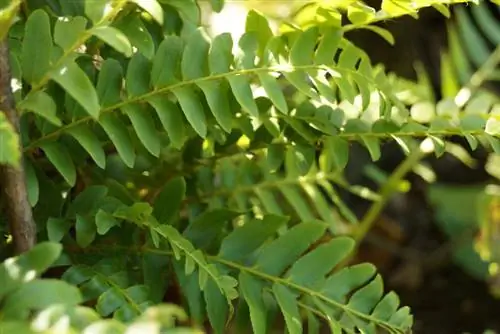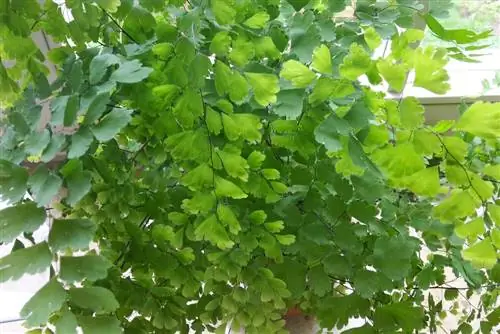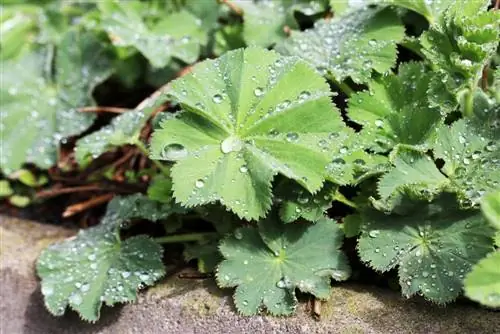- Author admin [email protected].
- Public 2023-12-17 03:39.
- Last modified 2025-01-24 12:45.
Ferns have been growing on earth for 400 million years. They still have an original appearance today. The plants feel at home in shady places with a lot of moisture. Due to their lush growth and sometimes extravagant shapes, some fern species are suitable as houseplants. Make sure children and pets do not come into contact with the plants.
Ferns: toxicity and protective measures
Ferns are among the popular house plants because of their tropical-looking fronds. Families with children and pet owners should be careful when cultivating the plant. Ferns release spores that cause symptoms of poisoning when taken orally. Unlike other plants, ferns do not produce flowers. They reproduce exclusively through spores, which also contain toxins.
- Numerous fern species endanger human and animal he alth
- Strength of toxic effect depends on species
- Symptoms of poisoning range from nausea to cardiac arrest
Lady fern is one of the eyelash fern family and is divided into 170 to 200 genera. In the house and in the garden, for example, you can keep rainbow ferns or the forest lady fern. This deciduous fern contains poisonous Filix active ingredients.
- Toxins cause serious reactions in lower animals
- Dangers for pets due to symptoms of poisoning, such as vomiting, diarrhea
- Filix active ingredients are generally safe for adults
- Children face a slight to moderate risk of poisoning after eating the leaves
Do you keep cats or dogs in your apartment? Remember that lady fern endangers the he alth of your animals. Indoor cats in particular tend to examine and nibble on plants in the house. Because of their wide fronds, ferns are particularly tempting. There are only a few species of ferns where animals can easily eat the tips of the fronds. These include, for example, the Cheilanthes tomentosa (rock fern) and the Cystopteris fragilis (fragile bladder fern).
Poisonous fern for cats

The lady fern, which is largely harmless to humans, causes serious symptoms of poisoning in domestic cats. A few bites on the stem or fronds of the athyrium - the botanical name - are enough to cause diarrhea or vomiting. Sensitive cats react to the toxins with increased salivation. This happens when they breathe in the fern spores. In an animal exposed to irritation over a long period of time, you will notice changes in temperament.
- Fern poisoning causes lethargic, dazed behavior in the cat
- Sensitive animals react to poisonous spores
- Dilated pupils as the first symptom of fern poisoning
The risk of a toxic reaction decreases in free-roaming cats. Her instinct warns her not to eat the fern. Therefore, you do not necessarily have to remove the plants from the garden. Within the apartment, indoor ferns should be placed in closed rooms. Cats are climbing artists and can climb any cupboard with ease. An elevated position of the fern does not provide any protection for the animal. Therefore, place indoor ferns in places that your indoor cat cannot reach. In a closed winter garden, the plants receive sufficient sunlight and a pleasant climate. In addition, the locked door effectively keeps children and pets away.
Fern: toxicity to dogs
The majority of indoor ferns, including lady ferns, are also found to be harmful to dogs' he alth. If the animal ingests the tips of the fronds orally, there is a risk of symptoms of poisoning such as:
- Lethargy
- Diarrhea
- bloated stomach
The animals often vomit parts of plants they have swallowed. This is a natural defense reaction of the body. If you notice that your dog is suffering from fern poisoning, contact the vet immediately. However, there is no antidote for the incompatible substances in the plants.
Therefore, the veterinarian stabilizes your dog's circulation and only treats the symptoms. To avoid toxic reactions, cultivate low-toxic ferns in your home. These include, for example, rib fern (Blechnum spicant) and maidenhair fern (Venus hair, Adiantum capillus-veneris). Both species are harmless to humans and animals.
Germany's most poisonous fern species
A commonly found fern in German forests is the bracken fern (Pteridium aquilinum). It is the most poisonous representative of the ferns. Its spores contain the enzyme thiaminase, which is considered to be bone-damaging and carcinogenic. In addition, contact with the leaves has a toxic effect. They contain the hydrogen cyanide glycosides and toxic saponin.
- Freshly sprouting leaves cause severe poisoning in humans and animals after consumption
- Entire plant has toxins
- Even a small amount of poison can have a fatal effect on small children and lower animals in the worst case
The bracken reaches an average height of up to two meters - rarely up to four meters. That's why it is one of the most popular ornamental plants in the home. Be sure to keep your offspring and pets away from the plant. Fern toxicity affects the entire plant. There is a risk of he alth complications if the frond and stem are consumed. In small children, puppies and kittens, inhaling the spores is enough to cause poisoning reactions.
Even young bracken shoots contain dangerous poisons. In adulthood, the plant produces additional toxins. These include the unstable glycoside ptaquiloside. The extent of the toxic reactions caused by the bracken depends on the part of the plant consumed, its quantity and the time of year.
Symptoms of poisoning in animals

If horses, goats or pigs ingest bracken in their diet, for example when grazing, it has a decomposing effect on vitamin B1. This causes the enzyme thiaminase. Affected animals suffer from disorders of the central nervous system (CNS). You notice slowed or disturbed movements as well as other motor disorders. Bracken fern has a more serious effect on cattle. Oral intake causes visible reactions within a short period of time. This includes bleeding in the mouth and nose. In addition, blood comes out of the metabolic organs. The red body fluid is found in the stool or urine of farm animals. In this case, veterinarians speak of “blood urine”.
- Brakern in cattle is a long-term cause of bladder and colon cancer
- Aboveground parts of the plant retain toxic effects after drying
- Milk from poisoned cows as a danger to humans
In small vertebrates such as cats and rabbits, consumption of bracken leads to blindness or the appearance of cancer. At the same time, circulatory shock poses an acute threat to life.
Tip:
The bracken is the most poisonous fern in Germany. If it settles in your garden or pasture, fight it by digging it up or mowing it down. Alternatively, the use of herbicides is suitable to protect children and pets from the toxic bracken plant.
Symptoms of fern poisoning
If people come into contact with the bracken and ingest spores, for example, symptoms of poisoning quickly set in. The characteristic signs of a toxic reaction include:
- Vomiting
- Stomachache
- Diarrhea
- motor disorders
- Fainting
- Heart failure
- Visual problems
- Disorders in movement sequence
- Breathing problems
In addition to the bracken, the worm fern (Dryopteris) is one of the poisonous fern species. Wrongly used as a medicine in the past, even a small amount of the plant leads to death after oral ingestion. In livestock, 100 grams of worm fern is enough to cause life-threatening complications. The rhizome and the stems of young shoots in particular are highly poisonous.






